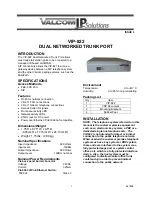
5-6
Catalyst 4500 Series Switch, Cisco IOS Software Configuration Guide - Cisco IOS XE 3.9.xE and IOS 15.2(5)Ex
Chapter 5 Configuring Virtual Switching Systems
Understanding Virtual Switching Systems
If either the VSS Active switch fails or all links that belong to the VSL port-channel fail, the VSS
Standby switch initiates a switchover and assumes the role of the VSS Active switch. If the previous VSS
Active switch has failed, it reloads and boots as the VSS Standby switch. However, if only the VSL
port-channel failure caused the switchover, the previous VSS Active switch enters recovery mode
(provided dual-active detection is configured). In this scenario, the previous VSS Active chassis (now in
recovery mode) carries no traffic and only monitors the VSL link. When one link in the VSL
port-channel is up, the recovery mode switch reloads and boots as a VSS Standby chassis. For additional
information about dual-active detection, see the
“Dual-Active Detection” section on page 5-23
.
Packet Handling
The VSS Active supervisor engine runs the Layer 2 and Layer 3 protocols and features for the VSS and
manages all ports on both switches.
The VSS uses VSL to communicate protocol and system information between the peer switches and to
carry data traffic between the switches when required.
Both switches perform packet forwarding for ingress traffic on their interfaces. If possible, ingress traffic
is forwarded to an outgoing interface on the same switch to minimize data traffic that must traverse the
VSL.
System Management
The VSS Active supervisor engine acts as a single point of control for the VSS. For example, the VSS
Active supervisor engine handles OIR of switching modules on both switches. The VSS Active
supervisor engine uses VSL to send messages to and from local ports on the VSS Standby switch.
The command console on the VSS Active supervisor engine is used to control both switches. In virtual
switch mode, the command console on the VSS Standby supervisor engine blocks attempts to enter
configuration mode.
The VSS Standby switch runs a subset of system management tasks. For example, the VSS Standby
switch handles its own power management, linecard bringup, and other local hardware management.
Quad-Supervisor (In-chassis Standby Supervisor Engine) Support
Beginning with IOS XE release 3.8.0E, Cisco Catalyst 4500-E switches configured with Supervisor
Engines 7-E, 7-LE, or 8E support Quad-Supervisor VSS Mode.
With Quad-Supervisor VSS mode, each chassis in the VSS supports a redundant supervisor engine,
called the in-chassis standby (ICS). The ICS supervisor engines use Route Processor Redundancy (RPR)
mode, and remain in RPR Standby Cold redundancy state. If the Active supervisor fails, the ICS
supervisor boots fully, and becomes the Active supervisor within the chassis, while the local chassis
remains nonoperational till SSO redundancy is established with the VSS Active supervisor.
The following table displays a matrix of the chassis that support Quad-Supervisor VSS mode, and the
corresponding number of supervisors required in each case.
Chassis
4507R+E
4507R-E
4510R-E
4510R+E
4503-E
3
3
3
3
4506-E
3
3
3
3
4507R+E
4
4
4
4
457R-E
4
4
4
4
Summary of Contents for Catalyst 4500 Series
Page 2: ......
Page 4: ......
Page 2086: ...Index IN 46 Software Configuration Guide Release IOS XE 3 9 0E and IOS 15 2 5 E ...
















































